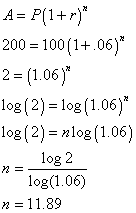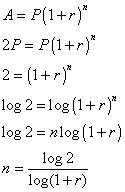Why Does The Rule of 72 Work?
|
Rule of 72: The time required to
double an investment at R percent compounded
annually is closely approximated by 72/R. For example, $100 invested at 6% compounded annually would double to $200 in approximately 72 / 6 or 12 years.
The Compound Interest Formula is:
For Annual Compounding (where m is 1), the formula becomes:
In the example above, the actual time required for $100 to
double is 11.89 years
and can be solved in the following manner:
----------------------------------------------------------------
Take the Compound Interest Formula, and solve for n:
Now, take the Rule of 72 and solve for n (remember to divide
R by 100 to get r):
Graph these two functions on a graphing calculator to see why the values
of n are very close. Use the trace function and change the
domain (values for r)
and the range (values for n) to be: |




